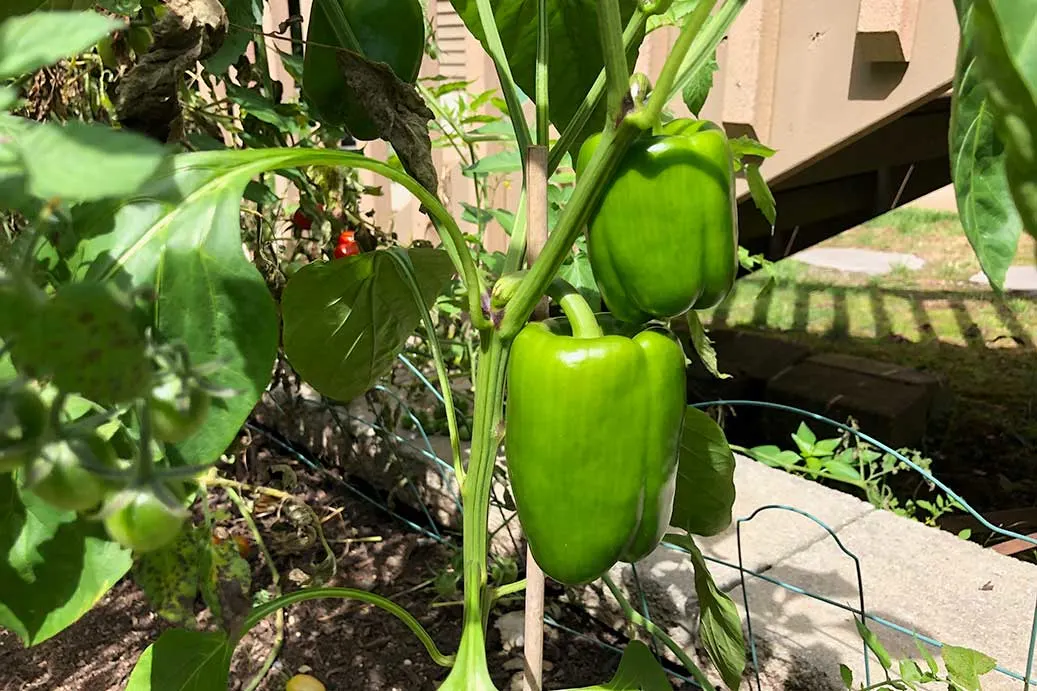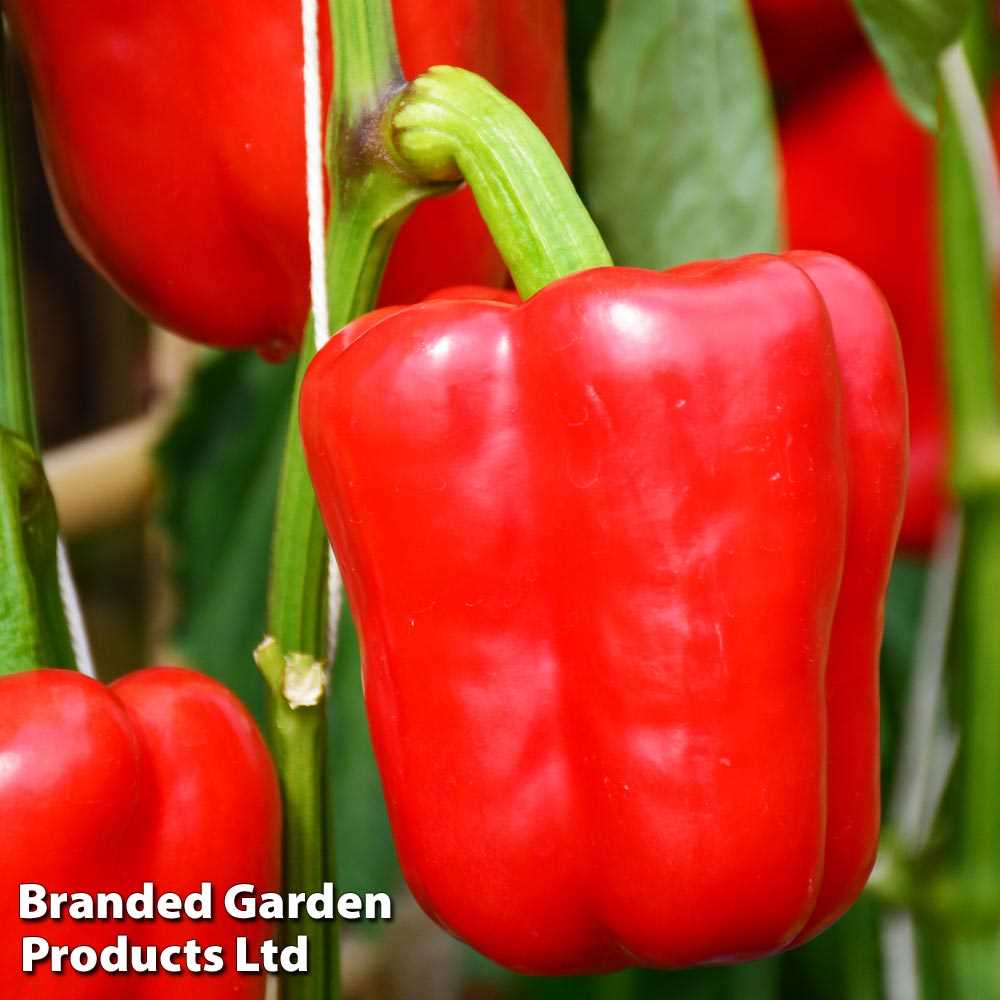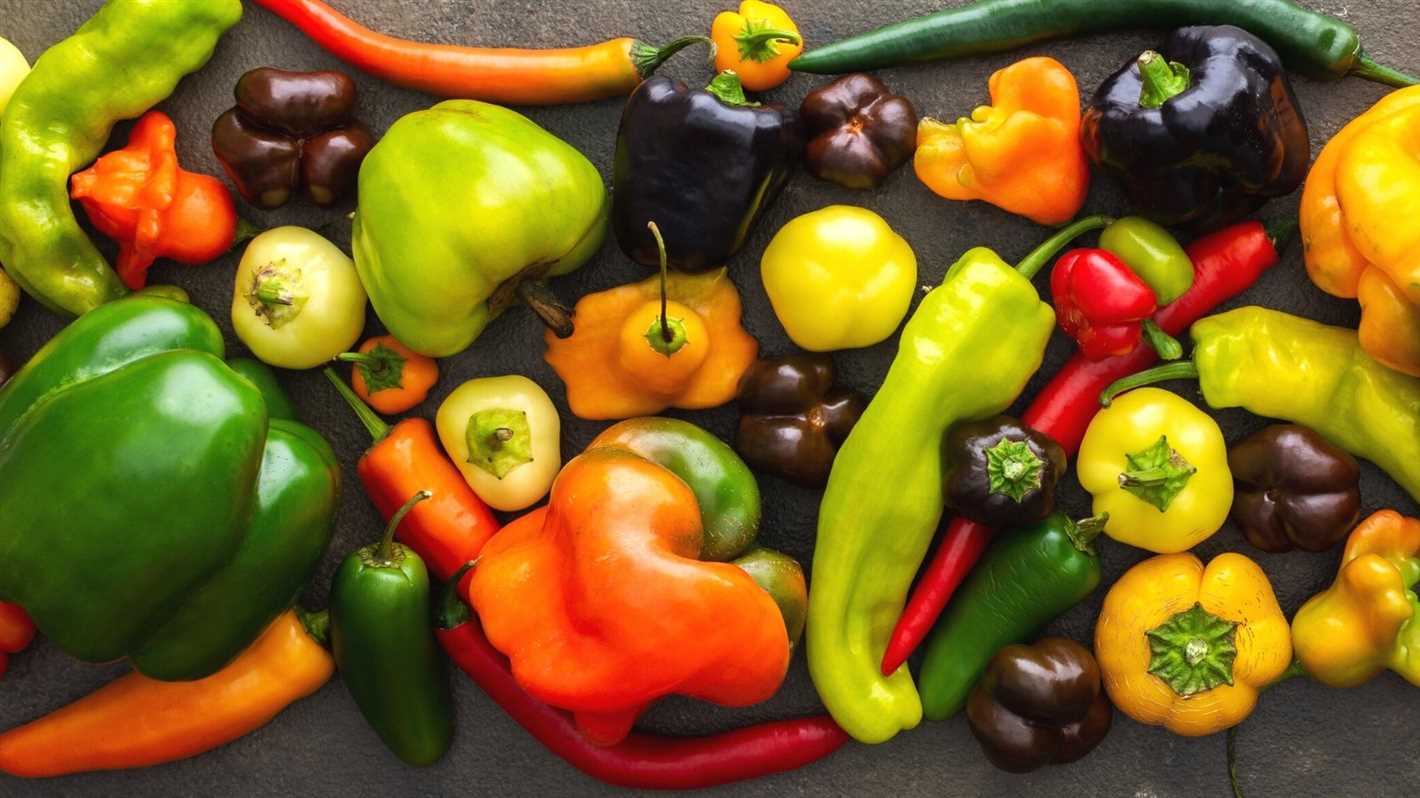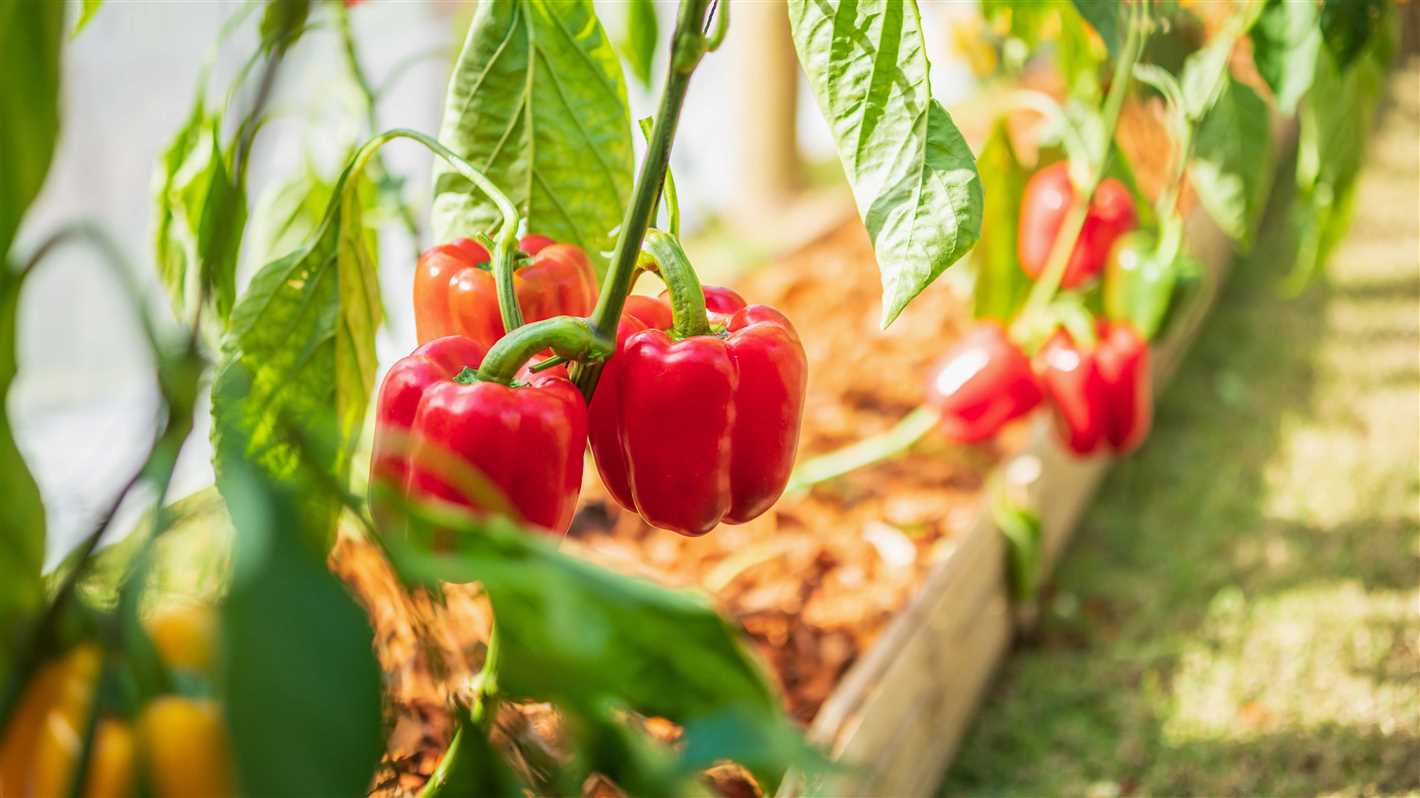- Sweet Pepper: A Productive Crop for Greenhouses and Gardens!
- Why Sweet Pepper is an essential crop for greenhouses and ground gardens
- Versatility
- Nutritional value
- High demand
- Benefits of growing Sweet Pepper in controlled environments
- Optimal conditions for cultivating Sweet Pepper in greenhouses
- Key considerations for growing Sweet Pepper in ground gardens
- Variety Selection
- Soil Preparation
- Planting
- Sunlight
- Watering
- Support
- Fertilization
- Pest and Disease Management
- Harvesting
- Choosing the right Sweet Pepper varieties for your greenhouse or garden
- Effective pest and disease management for Sweet Pepper crops
- 1. Prevention is key
- 2. Identify and monitor pests
- 3. Implement cultural control methods
- 4. Use organic pesticides and fungicides
- 5. Regularly scout and monitor for diseases
- Harvesting and storing Sweet Pepper for long-term use
- Harvesting Sweet Pepper
- Preparing Sweet Pepper for Storage
- Storing Sweet Pepper
- Delicious recipes and culinary uses for fresh Sweet Pepper
- 1. Stuffed Sweet Peppers
- 2. Sweet Pepper Salad
- 3. Sweet Pepper Stir-Fry
- 4. Sweet Pepper Salsa
- 5. Grilled Sweet Pepper Skewers
- Conclusion
- “Question-Answer”
- What is sweet pepper?
- How do I grow sweet peppers in a greenhouse?
- Can sweet peppers be grown in ground gardens?
- What are the benefits of growing sweet peppers?
- How long does it take for sweet peppers to mature?
- “Video” How to Grow Bell Peppers from Seed in Containers | Easy planting guide

Are you looking for a versatile and delicious vegetable to grow in your greenhouse or ground garden? Look no further than sweet peppers! These vibrant and nutritious vegetables are a must-have for any aspiring gardener.
Why choose sweet peppers?
First, sweet peppers come in a variety of colors and sizes, which makes them not only visually appealing but also great for adding diversity to your meals. From bright red to sunny yellow, there’s a pepper to suit everyone’s taste.
Second, sweet peppers are packed with vitamins A and C, as well as antioxidants, making them a healthy addition to any diet. They are also low in calories and fat, making them a guilt-free snack or ingredient.
But what really sets sweet peppers apart is their versatility in cooking.
You can stuff them with ingredients like cheese and herbs, slice them for salads, roast them for a smoky flavor, or even use them as a colorful addition to stir-fries and pasta dishes. The possibilities are endless!
So whether you have a greenhouse or a ground garden, sweet peppers are the perfect crop to grow. Not only will they add color and flavor to your meals, but they will also bring a sense of satisfaction and accomplishment as you watch them grow and thrive. Give sweet peppers a try and discover the joy of growing your own fresh produce!
Sweet Pepper: A Productive Crop for Greenhouses and Gardens!
Sweet peppers are not only delicious but also a highly productive crop that can be grown in both greenhouses and gardens. With their vibrant colors and sweet flavor, they add both visual appeal and taste to a variety of dishes.
Benefits of Growing Sweet Peppers:
- High Yield: Sweet peppers are known for their high yield, making them a cost-effective crop to cultivate.
- Versatility: They come in various colors, including red, yellow, orange, and green, which adds a beautiful touch to any garden or greenhouse.
- Nutritional Value: Sweet peppers are packed with vitamins A and C, as well as antioxidants.
- Disease Resistance: Many sweet pepper varieties are resistant to common diseases and pests, making them easier to grow and maintain.
Best Growing Practices:
- Location: Choose a spot in your greenhouse or garden that receives full sun, as sweet peppers require at least 6 hours of sunlight per day.
- Soil Preparation: Ensure the soil is well-drained and rich in organic matter. Amend the soil with compost before planting.
- Planting: Start seeds indoors 8-10 weeks before the last frost date. Transplant the seedlings to larger pots once they have two sets of leaves. Harden off the young plants before transplanting them into the greenhouse or garden.
- Spacing: Leave approximately 18-24 inches of space between each sweet pepper plant to allow for proper air circulation and growth.
- Watering: Sweet peppers need regular watering to keep the soil consistently moist, but not waterlogged.
- Fertilization: Apply a balanced fertilizer every 4-6 weeks during the growing season to provide necessary nutrients for the plants.
- Pest and Disease Control: Monitor your sweet pepper plants regularly for signs of pests or disease. Use organic pest control methods, such as neem oil or insecticidal soap, if necessary.
- Harvesting: Harvest sweet peppers when they reach the desired size and color. Cut the peppers from the plant using a sharp knife or shears.
Popular Sweet Pepper Varieties:
| Variety | Color | Characteristics |
|---|---|---|
| Bell Boy | Green to Red | Thick walls, perfect for stuffing and grilling |
| California Wonder | Green to Red | Classic bell pepper, great for salads and cooking |
| Jingle Bells | Green to Red | Small, sweet peppers, ideal for snacking and salads |
| Cubanelle | Yellow to Red | Mild, thin-walled peppers, popular in Latin cuisine |
Whether you have a greenhouse or a ground garden, sweet peppers are a rewarding and productive crop to grow. With proper care and attention, you can enjoy a bountiful harvest of sweet, vibrant peppers that will elevate your culinary creations.
Why Sweet Pepper is an essential crop for greenhouses and ground gardens
Sweet pepper, also known as bell pepper or capsicum, is a popular crop that is essential for both greenhouses and ground gardens. Its versatility, nutritional value, and high demand make it an excellent choice for any gardener or farmer.
Versatility
Sweet pepper is a versatile crop that can be grown in a variety of conditions. It thrives in both greenhouses and ground gardens, making it suitable for different types of cultivation. Whether you have limited space or a large garden, sweet pepper can be grown successfully.
Additionally, sweet pepper comes in different colors, such as red, yellow, orange, and green. This adds variety and visual appeal to your garden or greenhouse. You can also choose between different sweet pepper varieties, each with its unique taste and characteristics.
Nutritional value


Sweet pepper is not only delicious but also packed with essential nutrients. It is an excellent source of vitamins A, C, and E, as well as dietary fiber and antioxidants. These nutrients support overall health and strengthen the immune system.
Furthermore, sweet pepper is low in calories and fat, making it a healthy choice for those watching their weight. It can be enjoyed raw in salads, stuffed with other ingredients, or cooked in various dishes. Its sweet and crunchy texture adds a delightful flavor to any recipe.
High demand
The demand for sweet pepper is consistently high due to its versatile culinary uses and nutritional benefits. Consumers appreciate its vibrant colors, mild sweetness, and crunchy texture. Sweet pepper is a staple ingredient in many cuisines worldwide and is used in a wide variety of dishes, from salads and stir-fries to soups and stews.
Whether you plan to sell your harvest or enjoy it for personal consumption, sweet pepper is a crop that is sure to be in demand. Its popularity makes it a profitable choice for farmers and a rewarding experience for gardeners.
| Benefits of Growing Sweet Pepper | Benefits of Using Sweet Pepper in Culinary Dishes |
|---|---|
|
|
In conclusion, sweet pepper is an essential crop for both greenhouses and ground gardens. Its versatility, nutritional value, and high demand make it an excellent choice for any gardener or farmer. Whether you are a beginner or an experienced horticulturist, sweet pepper offers numerous benefits and a delicious addition to your meals.
Benefits of growing Sweet Pepper in controlled environments
Growing sweet pepper in controlled environments, such as greenhouses, offers several benefits compared to traditional ground gardens:
- Extended growing season: With controlled environments, you can extend the growing season of sweet peppers, allowing for a longer harvest period.
- Protection from weather conditions: Greenhouses provide protection from extreme weather conditions, such as frost, hail, or heavy rain, which can damage or even destroy the pepper plants.
- Pest and disease control: Controlled environments help in controlling pests and diseases that commonly affect sweet peppers. With proper monitoring and preventive measures, you can minimize the risk of infestation and reduce the need for chemical pesticides.
- Optimal growing conditions: In greenhouses, you can control factors like temperature, humidity, and light, creating optimal growing conditions for sweet peppers. This allows the plants to thrive and produce higher yields.
- Improved quality and appearance: Sweet peppers grown in controlled environments often have improved quality and appearance compared to those grown in ground gardens. They tend to have more uniform shape, size, color, and flavor.
- Higher yields: By providing optimal growing conditions and minimizing the risk of pests and diseases, growing sweet peppers in controlled environments can result in higher yields. This can be beneficial for commercial growers looking to maximize their production.
- Year-round production: With the ability to control the environment, sweet pepper production can be maintained throughout the year, allowing for a continuous supply regardless of the season.
Optimal conditions for cultivating Sweet Pepper in greenhouses
- Temperature: Sweet Pepper thrives in a warm environment, with an optimal temperature range of 18-24°C during the day and 15-18°C at night. Maintaining a consistent temperature is crucial for the successful cultivation of Sweet Pepper in greenhouses.
- Lights: Sweet Pepper plants require a minimum of 12-14 hours of sunlight each day for optimal growth and fruit development. Supplemental lighting may be necessary in greenhouses with insufficient natural light.
- Soil: The soil should be well-draining, fertile, and rich in organic matter. A pH level between 6.0 and 7.0 is ideal for Sweet Pepper cultivation. Regular soil testing and adjusting the pH if needed is recommended.
- Watering: Sweet Pepper plants need regular watering to keep the soil consistently moist but not waterlogged. The frequency of watering will depend on environmental conditions, but generally, plants should be watered deeply once or twice a week.
- Fertilization: Providing the right nutrients is crucial for Sweet Pepper plants. A balanced fertilizer with a ratio of nitrogen (N), phosphorus (P), and potassium (K) of 5-10-10 or 10-20-20 is recommended. Fertilizers should be applied according to the manufacturer’s instructions.
- Pest and disease control: Sweet Pepper plants are susceptible to various pests and diseases. Regular monitoring and timely action are necessary to prevent infestations and diseases. Integrated pest management (IPM) practices and the use of organic pest control methods are recommended.
- Support: Sweet Pepper plants may benefit from support systems, such as trellises or stakes, to keep the plants upright and support heavy fruit loads. This helps prevent the plants from bending or breaking under their weight.
Growing Sweet Pepper in greenhouses offers several advantages, including extended growing seasons, consistent environmental control, and protection from adverse weather conditions. By providing optimal conditions and proper care, you can enjoy a bountiful harvest of delicious and nutritious Sweet Pepper from your greenhouse.
Key considerations for growing Sweet Pepper in ground gardens
When it comes to growing sweet peppers in ground gardens, there are several key considerations to keep in mind. These factors can greatly impact the success and yield of your sweet pepper plants:
Variety Selection
Choose the right sweet pepper variety for your specific growing conditions and preferences. Consider factors such as taste, color, size, and disease resistance. Some popular sweet pepper varieties include bell peppers, banana peppers, and cubanelle peppers.
Soil Preparation
Prepare the soil before planting sweet pepper plants. The soil should be well-drained, fertile, and rich in organic matter. It’s recommended to perform a soil test to determine and adjust the pH level, as sweet peppers prefer a slightly acidic soil with a pH between 6.0 and 6.8.
Planting
Plant sweet pepper transplants in the ground after the danger of frost has passed and the soil has warmed up. Space the plants according to the specific variety’s requirements, typically around 18 to 24 inches apart.
Sunlight
Sweet peppers require full sunlight to thrive and produce abundant yields. Choose a planting location that receives at least 6 to 8 hours of direct sunlight each day.
Watering
Keep the soil consistently moist, but not waterlogged, throughout the growing season. Avoid overwatering or allowing the soil to dry out completely. Consistent watering helps ensure proper fruit development and prevents issues like blossom end rot.
Support
Consider providing support for your sweet pepper plants, especially if you’re growing larger varieties. Staking or cages can help prevent the plants from falling over due to the weight of the fruit.
Fertilization
Apply a balanced fertilizer according to the specific needs of your sweet pepper plants. It’s beneficial to incorporate organic matter, such as compost or well-rotted manure, into the soil before planting. Additionally, regular fertilization throughout the growing season can help promote healthy growth and high yields.
Pest and Disease Management
Monitor your sweet pepper plants for pests like aphids, spider mites, and pepper maggots. Implement integrated pest management strategies, such as handpicking, insecticidal soaps, or organic pesticides, if necessary. Additionally, prevent diseases by practicing crop rotation, providing adequate air circulation, and avoiding overhead watering.
Harvesting
Harvest sweet peppers when they have reached the desired color and size. Most varieties are ready to be harvested when the peppers are firm, glossy, and fully developed. Using a sharp knife or pruners, cut the peppers from the plant to avoid damaging the stems or other fruits.
By considering these factors and providing proper care and attention, you can successfully grow sweet peppers in ground gardens and enjoy a bountiful harvest.
Choosing the right Sweet Pepper varieties for your greenhouse or garden
If you are planning to grow sweet peppers in your greenhouse or garden, it is important to choose the right varieties that will thrive in your specific growing conditions. With so many different types of sweet peppers available, it can be overwhelming to make a decision. Here are some factors to consider when choosing the right sweet pepper varieties:
- Growing Location: Different sweet pepper varieties have different temperature and sunlight requirements. Consider the climate and amount of sunlight your greenhouse or garden receives when selecting varieties. Some varieties are more heat-tolerant, while others prefer cooler temperatures.
- Plant Size: Sweet pepper plants vary in size and growth habit. Some varieties are compact and bushy, making them a good choice for smaller gardens or containers. Others are more sprawling and require more space to grow.
- Fruit Size and Shape: Sweet peppers come in a variety of sizes and shapes, ranging from small and round to large and elongated. Consider what size and shape of peppers you prefer for cooking or snacking.
- Flavor and Taste: Sweet peppers can have varying levels of sweetness and flavor. Consider the taste profile you prefer when selecting varieties. Some peppers are milder, while others have a more robust flavor.
- Color: Sweet peppers come in a wide range of colors, including green, red, yellow, orange, and even purple. Consider what color peppers you prefer and if you want a mix of colors for visual appeal.
Once you have considered these factors, you can start researching specific sweet pepper varieties that meet your requirements. Take into account the recommended growing conditions and care instructions for each variety to ensure success in your greenhouse or garden.
| Variety | Plant Size | Fruit Size and Shape | Flavor | Color |
|---|---|---|---|---|
| Bell Peppers (Capsicum annuum) | Medium to large | Large, blocky shape | Mild and sweet | Green, red, yellow, orange |
| Italian Sweet Peppers (Capsicum annuum) | Medium | Long, tapered shape | Mild and slightly sweet | Green, red, yellow |
| Mini Sweet Peppers (Capsicum annuum) | Compact | Small, snack-sized | Mild and sweet | Various colors |
Remember to provide the necessary care and maintenance for your sweet pepper plants, such as regular watering, fertilizing, and pruning. By choosing the right sweet pepper varieties and providing the proper care, you can enjoy a bountiful harvest of delicious peppers in your greenhouse or garden.
Effective pest and disease management for Sweet Pepper crops
Growing Sweet Pepper crops can be a rewarding and satisfying endeavor, but like any crop, they can be susceptible to pests and diseases. Implementing effective pest and disease management strategies is essential to ensure the health and productivity of your Sweet Pepper plants.
1. Prevention is key
One of the most effective ways to manage pests and diseases in Sweet Pepper crops is through prevention. By implementing proper sanitation practices and creating a healthy growing environment, you can minimize the risk of infestations and infections.
- Remove any plant debris, fallen fruits, or weeds from the growing area as they can harbor pests and diseases.
- Regularly inspect your plants for signs of pests or diseases, such as discoloration, wilting, or chewing damage.
- Practice crop rotation to disrupt pest and disease life cycles.
- Keep the greenhouse or garden clean and free from excess moisture, as damp conditions can promote fungal growth.
2. Identify and monitor pests
It’s important to identify and monitor pests in your Sweet Pepper crops to take timely action before they can cause significant damage. Some common pests that can affect Sweet Peppers include aphids, mites, whiteflies, and thrips.
- Regularly inspect your plants for signs of infestation, such as distorted leaves, webbing, or the presence of insects.
- Use sticky traps or yellow sticky cards to monitor flying pests like whiteflies.
- Consider using beneficial insects, such as ladybugs or predatory mites, to control pest populations.
3. Implement cultural control methods
Cultural control methods can help manage pests and diseases without relying heavily on chemical interventions.
- Practice companion planting by growing aromatic herbs like basil or marigold alongside Sweet Peppers to repel pests.
- Use physical barriers, such as row covers or insect netting, to protect your plants from insects.
- Encourage natural predators, such as birds or spiders, to inhabit your greenhouse or garden to control pest populations.
4. Use organic pesticides and fungicides


If pest or disease pressure becomes severe and cultural control methods are insufficient, you may need to resort to organic pesticides or fungicides.
- Choose organic-approved products and follow the instructions carefully.
- Apply pesticides or fungicides during the recommended times to ensure maximum effectiveness.
- Rotate between different classes of pesticides to prevent the development of pesticide resistance.
5. Regularly scout and monitor for diseases
Various diseases can affect Sweet Pepper crops, such as bacterial leaf spot, powdery mildew, or viral infections. Regular scouting and monitoring can help detect these diseases early.
- Inspect the leaves, stems, and fruits of your plants for any signs of disease, such as spots, discoloration, or unusual growth.
- If you suspect the presence of a disease, remove and destroy infected plants to prevent further spread.
- Avoid overhead watering to minimize the risk of fungal diseases.
By implementing these effective pest and disease management strategies, you can ensure the health and productivity of your Sweet Pepper plants, ultimately maximizing your crop yield and quality.
Harvesting and storing Sweet Pepper for long-term use
Sweet peppers are a versatile and delicious vegetable that can be enjoyed in a variety of dishes. To make sure you have a fresh supply of sweet peppers even after the harvest season is over, it is important to properly harvest and store them for long-term use.
Harvesting Sweet Pepper


The timing of when to harvest sweet peppers is crucial for their flavor and storage potential. Here are some tips for harvesting sweet peppers:
- Wait until the peppers have fully matured and reached their desired color. For most sweet pepper varieties, this means waiting until they have turned red, yellow, or orange.
- Use a sharp knife or scissors to cut the pepper off the plant, leaving a short stem attached. Avoid pulling or twisting the pepper, as this can damage the plant.
- Harvest peppers regularly, as leaving them on the plant for too long can hinder the plant’s productivity and cause the peppers to become overripe.
Preparing Sweet Pepper for Storage
Before storing sweet peppers, it is important to properly prepare them to ensure their freshness and longevity. Follow these steps:
- Wash the peppers gently with cool water to remove any dirt or debris.
- Pat the peppers dry with a clean towel or let them air dry.
- Inspect the peppers for any signs of damage or disease. Discard any peppers that are bruised, rotten, or moldy.
Storing Sweet Pepper
There are several methods for storing sweet peppers, depending on your preference and the available space:
- Refrigeration: Sweet peppers can be stored in the refrigerator for up to two weeks. Place them in a perforated plastic bag or a vegetable crisper to retain their moisture.
- Freezing: Sweet peppers can also be frozen for long-term storage. Wash, seed, and slice the peppers before blanching them in boiling water for a few minutes. After blanching, quickly cool the peppers in ice water and drain them. Pack the peppers in freezer-safe containers or bags and store them in the freezer for up to 12 months.
- Drying: Drying sweet peppers is another option for long-term storage. Slice the peppers into thin strips and lay them on a baking sheet. Place the baking sheet in an oven set to the lowest temperature (around 140°F or 60°C) and leave the door slightly ajar to allow moisture to escape. Stir the peppers occasionally and check for doneness after several hours. Once dried, store the peppers in an airtight container in a cool, dark place.
By following these harvesting and storing methods, you can enjoy the crisp and flavorful taste of sweet peppers long after the growing season has ended.
Delicious recipes and culinary uses for fresh Sweet Pepper


If you are lucky enough to have a bountiful harvest of fresh sweet peppers from your greenhouse or ground garden, you might be wondering what delicious dishes you can create with these flavorful vegetables. Luckily, there are plenty of culinary uses for sweet peppers, from appetizers to main dishes.
1. Stuffed Sweet Peppers
One popular way to enjoy sweet peppers is by stuffing them with a savory filling. You can make a classic filling using a mixture of cooked rice, ground meat, onions, and herbs. You can also get creative and stuff them with a vegetarian filling like quinoa, mushrooms, and cheese. Bake the stuffed peppers in the oven until they are tender and the filling is heated through.
2. Sweet Pepper Salad
A refreshing and colorful salad can be made using sweet peppers. Slice the peppers into thin strips and combine them with other vegetables like cucumbers, tomatoes, and onions. Toss the salad with a light vinaigrette dressing and serve it as a side dish or a light lunch.
3. Sweet Pepper Stir-Fry
Sweet peppers are great for stir-frying because they retain their crispness and add a burst of flavor to the dish. Chop the peppers into thin strips and stir-fry them with other vegetables like carrots, broccoli, and snow peas. Add your choice of protein, such as chicken or tofu, and season with soy sauce and other Asian-inspired spices.
4. Sweet Pepper Salsa
Add a sweet and tangy twist to your salsa by including sweet peppers. Finely chop the peppers and combine them with diced tomatoes, onions, cilantro, lime juice, and spices like cumin and chili powder. Serve the salsa with tortilla chips or use it as a topping for grilled meats and tacos.
5. Grilled Sweet Pepper Skewers
For a tasty and visually appealing appetizer or side dish, make grilled sweet pepper skewers. Cut the peppers into chunks and thread them onto skewers along with other vegetables like cherry tomatoes and zucchini. Brush the skewers with olive oil, season with salt and pepper, and grill them until they are slightly charred and tender.
Conclusion
Sweet peppers are a versatile ingredient that can be used in a variety of delicious dishes. Whether you prefer them stuffed, in salads, stir-fries, salsas, or grilled, sweet peppers add a unique flavor and vibrant color to any recipe. So make sure to make the most of your sweet pepper harvest and experiment with these culinary uses!
“Question-Answer”
What is sweet pepper?
Sweet peppers, also known as bell peppers or capsicum, are a type of vegetable that comes in various colors like red, yellow, and green. They have a sweet and mild flavor and are often used in cooking.
How do I grow sweet peppers in a greenhouse?
To grow sweet peppers in a greenhouse, you will need to provide them with a consistent temperature, plenty of sunlight, and regular watering. Plant the seeds in well-draining soil and transplant the seedlings to larger pots once they are a few inches tall. Ensure proper ventilation in the greenhouse to prevent diseases. Harvest the peppers when they are firm and fully colored.
Can sweet peppers be grown in ground gardens?
Yes, sweet peppers can be grown in ground gardens as well. Choose a sunny spot in your garden with well-draining soil. Prepare the soil by adding compost or organic matter. Plant the seeds or seedlings in rows or raised beds, making sure to space them adequately. Water the plants regularly and provide support as they grow taller. Harvest the peppers when they reach the desired size and color.
What are the benefits of growing sweet peppers?
Growing sweet peppers can have several benefits. First, they are rich in vitamins and antioxidants, making them a nutritious addition to your diet. Second, they can be easily grown in both greenhouses and ground gardens, making them a versatile crop. Finally, growing your own sweet peppers allows you to enjoy their freshness and flavor, and it can be a rewarding gardening experience.
How long does it take for sweet peppers to mature?
The time it takes for sweet peppers to mature can vary depending on the variety and growing conditions. In general, it takes about 60-90 days from planting to harvest. However, some varieties may take longer. It is important to check the specific instructions provided with the seeds or seedlings you are planting for more accurate information.







